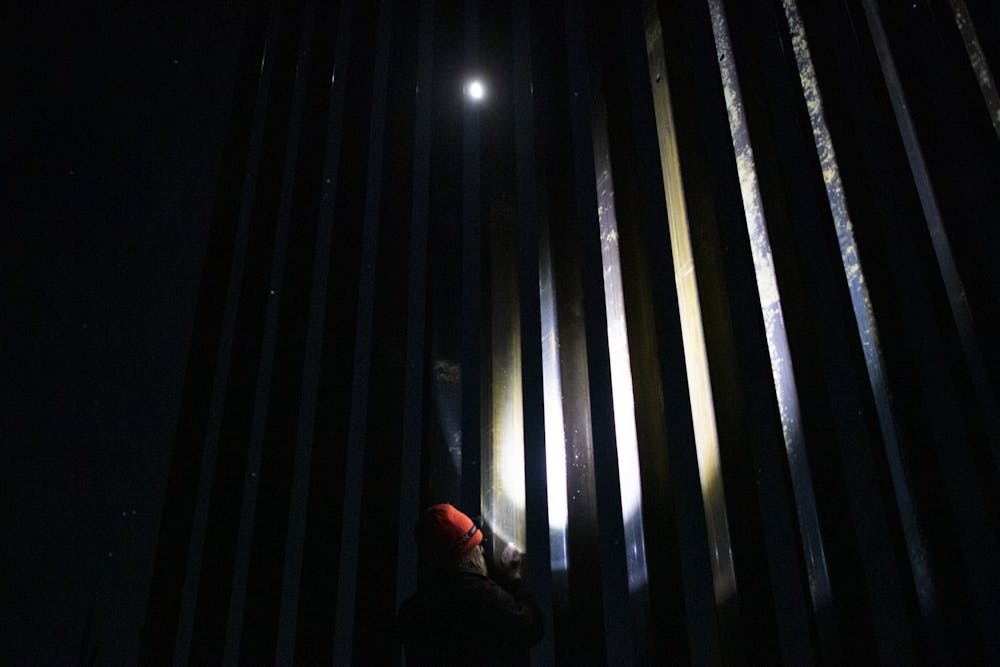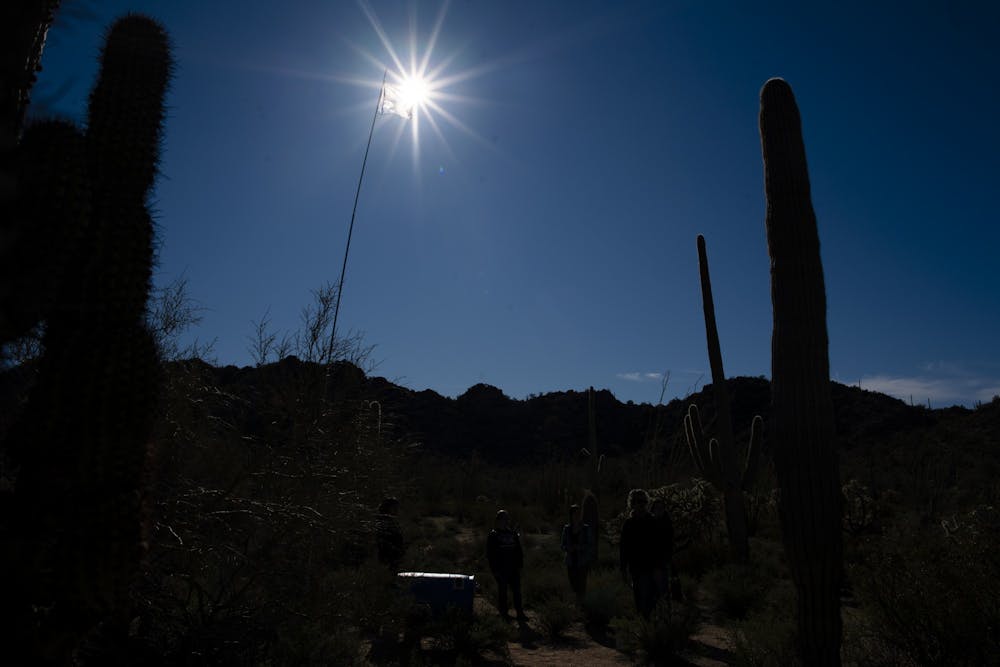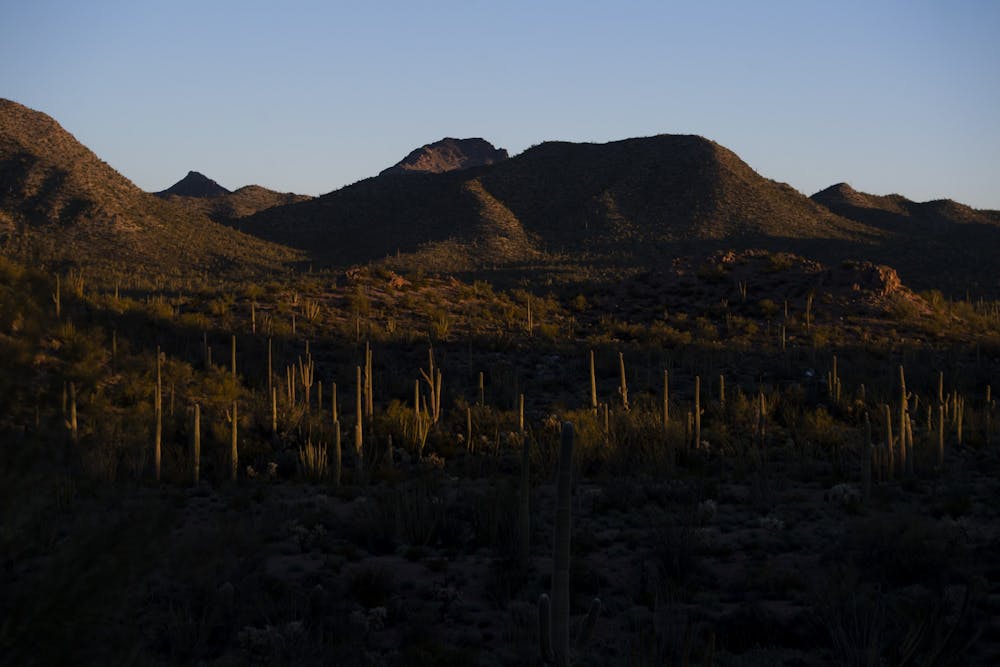Editors Note: This story contains strong language that has been censored throughout.
ORGAN PIPE CACTUS NATIONAL MONUMENT — At 4:30 a.m. on Feb. 15, a group of ASU students awoke to a black desert morning and proceeded to head south to the border.
Packed in four cars, they drove to Senita Basin in Organ Pipe Cactus National Monument with the intention to make sound recordings of the environment.
With them was Glenn Weyant, a former journalist turned sound sculptor and border musician.
Heading along the dark road in a Ford Expedition, Weyant told the driver to stop at a gap between the newly constructed border wall between Mexico and the United States. He jumped out and ran to it. He stopped between the gap, placed his hands on the wall and began to bang on it as if it was an instrument.
The two-day trip was planned by Sabine Feisst, a School of Music professor and co-director of the Acoustic Ecology Lab at ASU, and featured students from the lab and her Desert Music graduate class.
The reason Feisst took her students on this trip was to further research for the Acoustic Ecology Lab, which aims to engage communities through sound, and builds a database of recordings that can help predict climate impact on our environments through sound.
Inspired by the activism and trips of NAU professor of Spanish and Director of Latin American Studies, Robert Neustadt, Feisst wanted to give her students a similar experience on the border, centering more around the sounds of the land.
“I’m focusing on desert sounds and music, of the desert, about the desert, in the desert,” Feisst said.
Weyant and Neustadt
The Desert Music class, which was Feisst's idea, won her the Evelyn Smith Professorship, which is only awarded once every three years in the School of Music.
The professorship came with a stipend that gave Feisst the funding to bring in an artist to present to students. Feisst chose Weyant, a musician she had in mind since the early formations of the class.
“I thought, yeah, I should actually bring Glenn (Weyant) here because not only does he know a ton about the Sonoran Desert and has lived here for 25 years, he does all this creative stuff you know, listening and jamming with environmental sounds," Feisst said.
In 2006, Weyant began to play music on the border wall. He was interested in experimental music and began to use the wall as his instrument to help bring attention to the migrant story.
During that time, Weyant connected with fellow activist and musician Neustadt, who after taking his students to the border and Mexico to show them what the journey looks like, became involved with activism centered on the migrants’ journey.
“It started as teaching; it was just teaching,” Neustadt said. “I didn’t know we were going to the bottom of our souls.”
The trip Neustadt took his students on, which inspired Feisst, is five days and took them through both sides of the border, showing them the realities of what the grueling journey can look like, including morgues containing the bodies of migrants who had died, detention centers and the desert terrain they must cross.
“When you stand in the desert where someone has died,” Neustadt said. “It changes you.”
Neustadt and Weyant would become collaborators, creating music concerning the border and the migration that occurs through it.
Their work inspired Feisst to create a similar journey for her students, showing them the uniqueness of the natural sound in the desert while bringing in the perspectives of musicians who have played in the land for years.
Weyant left Arizona and moved to Vermont in 2018. He felt a desire to remove himself from the wall after 12 years of seeing the worst the borderlands had to offer.
Weyant said the final straw was when he was on a soundwalk making more recordings of the wall. At the border, he was taking in the audio of an incoming monsoon and listening to the cacti singing in the wind. All of a sudden, he spotted a man in a white shirt covered in dirt, his jeans tucked into his boots like a cowboy.
Weyant asked himself if he should give the man water. But he thought helping him might put him at risk, because Weyant knew Border Patrol had been watching. Weyant was also weary of putting himself at risk, as it is a crime to help migrants along the border.
But if he left the man there, is he abandoning someone in their time of need?
“When I looked at him, and I looked into his eyes, he was so f------ scared,” Weyant said. “And I'm sitting there thinking, I'm trying to figure like, what the f--- is going on?”
Weyant calls that feeling of moral struggle “mauerkrankheit,” a word in German meaning "wall disease," developed when Germany itself was separated by a wall.
In any other place, if people were in need, you wouldn’t think about helping them — you would just do it, Weyant said.
“Out here, you have to question your morality,” Weyant said.
After that, Weyant decided that he had had enough; he had done what he could to tell the story of the border, and it was time to get out of Arizona.
This trip with the students would be the first time Weyant returned since then.
Day One
Members of the class arrived around 1 p.m. at the Kris Eggle Visitor Center to meet, talk to park rangers, and then head down to their campground. Soon after, the group was on-site and setting up their camps.
Neustadt grabbed his guitar and filled the camp with his song "Maricopa Shuffle."
“Don't try to feed your family today,” Neustadt sang. “That’s not the Arizona way. No señor, you can’t stay.”
Once everything was set up, the group began their first activity: a soundwalk through Bull Pasture Trail. There was no talking — all that could be heard were the crunches of shoes on the rocks and sticks on the path, and the sounds of insects buzzing and each bird's unique call.
On the walk, Feisst explained active listening, a practice where listeners focus on sounds as a whole and their interconnectedness in creating the sonic environment.
Feisst said active listening requires students to focus on how the shape of the land and the plants within it influences the sounds. Together, these sounds create what is heard in an environment and can signal the health of that area.
Feisst said focusing completely on the sounds can bring the listener closer to their surroundings. The more the students listened, the more precisely they heard specific sounds, and the more other senses picked up as well.
After, they returned to camp for dinner and recreated the sounds they heard on their walk. To end the night, Paine played his flute and Neustadt sang and played the guitar.
Day Two
The final day of the trip began under the still star-filled sky so that students could hear and witness the transition from daybreak to sunrise.
Their goal was to head to the Senita Basin Trail to fulfill the main purpose of the Acoustic Ecology Lab: to document the sounds of the changing land.
The group drove through the dirt trail less than 200 yards from the wall. The lights of Sonoyta, Mexico shone through the pitch black sky on the other side of the 30-foot high fence.
At one point, Weyant stopped, and the class followed him to a large gap in the wall. He slowly placed his hands on it and began to hit it. The sounds could be heard all the way from the road, and quickly he began to create a metallic rhythm.
Many in the class began to play as well, filling the empty land with the beat of their hands on the metal.
Afterward, Weyant and Neustadt remarked that the only silver lining about the wall was that it sounded pretty damn good.
Soon they arrived at the Basin, and each individual, armed with a sound recorder, headed out into the desert to find their own spot to lie down and record the sounds of the surrounding land.
For close to two hours, each person was on their own. Everyone sat in silence as night turned to day, and they slowly became drenched in the sun's light. What seemed to be dozens of birds came to life, filling the basin with their music.
The recordings made would later be added to the Acoustic Ecology Lab’s database to continually track the altering sounds of the land.
This data helps track ongoing changes that affect the animal and plant population. It also helps give information about the changing landscape, with construction and climate change altering what the basin sounds like.
Feisst said the trip was a success. Students were exposed to nature in a way they had never been before and they had learned first-hand what the border looked like. She hopes to do this two more times for her future Desert Music classes.
Eventually, the students left in the groups they had come with and all that was left were the sounds they came to hear.
Reach the reporter at wmyskow@asu.edu and follow @wmyskow on Twitter.
Like The State Press on Facebook and follow @statepress on Twitter.

Wyatt Myskow is the project manager at The State Press, where he oversees enterprise stories for the publication. He also works at The Arizona Republic, where he covers the cities of Peoria and Surprise.






